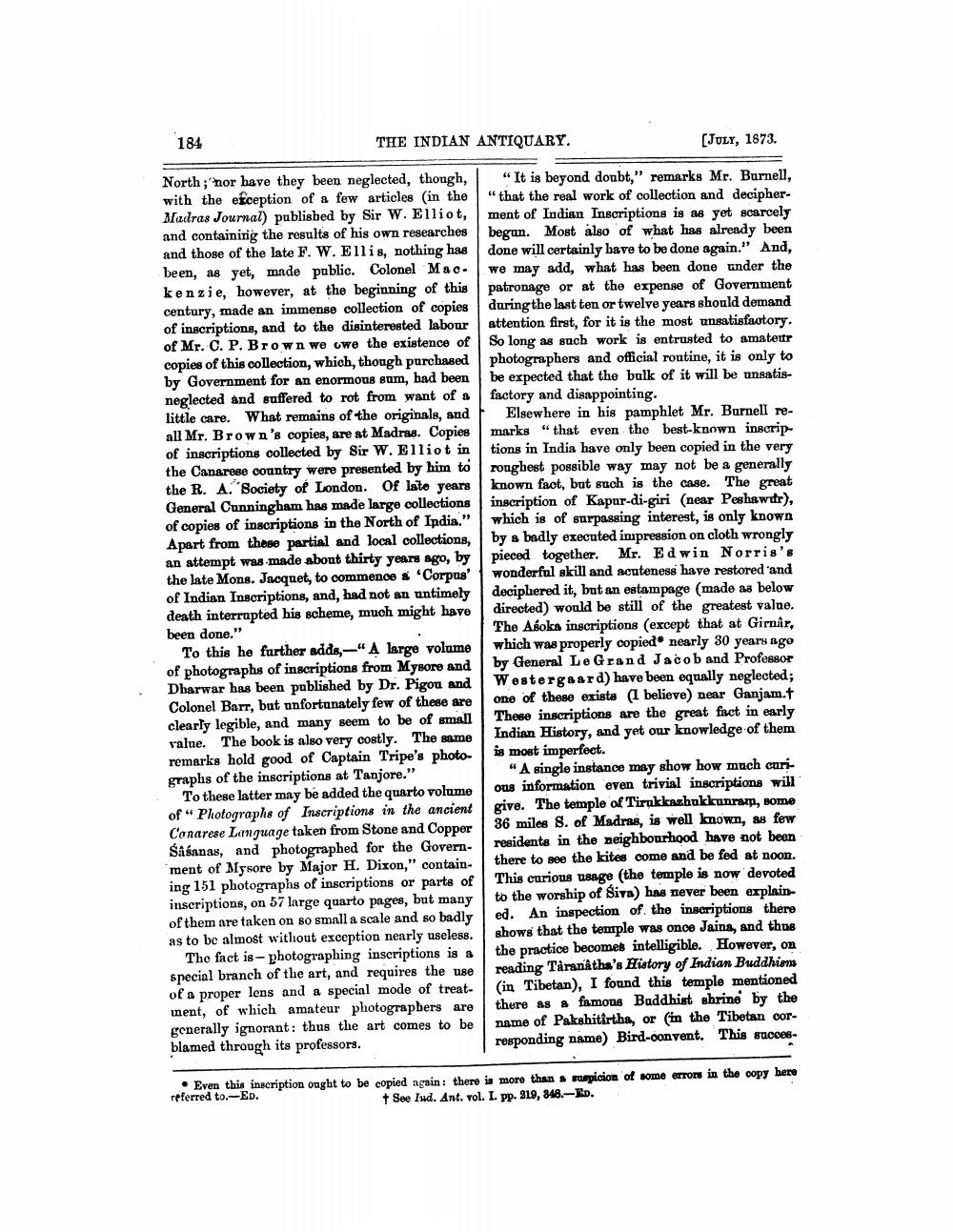________________
184
THE INDIAN ANTIQUARY.
(JULY, 1873.
North ; 'nor have they been neglected, though, with the efception of a few articles in the Madras Journal) published by Sir W. Elliot, and containinig the results of his own researches and those of the late F. W. Ellis, nothing has been, as yet, made public. Colonel Mac. kenzie, however, at the beginning of this century, made an immense collection of copies of inscriptions, and to the disinterested labour of Mr. C. P. Brown we uwe the existence of copies of this collection, which, though purchased by Government for an enormous sum, had been neglected and suffered to rot from want of a little care. What remains of the originals, and all Mr. Brown's copies, are st Madras. Copies of inscriptions collected by Sir W. Elliot in the Canarese country were presented by him to the R. A. Society of London. Of late years General Cunningham has made large collections of copies of inscriptions in the North of India." Apart from these partial and local collections, an attempt was made about thirty years ago, by the late Mons. Jacquet, to commence s "Corpus' of Indian Inscriptions, and, had not an untimely death interrupted his scheme, much might have been done."
To this he farther adds, -"A large volume of photographs of inscriptions from Mysore and Dharwar has been published by Dr. Pigon and Colonel Barr, but unfortunately few of these are clearly legible, and many seem to be of small value. The book is also very costly. The same remarks hold good of Captain Tripe's photographs of the inscriptions at Tanjore."
To these latter may be added the quarto volume of Photographs of Inscriptions in the ancient Canarese Language taken from Stone and Copper Sašanas, and photographed for the Government of Mysore by Major H. Dixon,"containing 151 photographs of inscriptions or parts of inscriptions, on 57 large quarto pages, but many of them are taken on so small a scale and so badly as to be almost without exception nearly useless.
The fact is-photographing inscriptions is a special branch of the art, and requires the use of a proper lens and a special mode of treatinent, of which amateur photographers are generally ignorant: thus the art comes to be blamed through its professors.
"It is beyond doubt," remarks Mr. Burnell, "that the real work of collection and decipherment of Indian Inscriptions is as yet scarcely begun. Most also of what has already been done will certainly bave to be done again." And, we may add, what has been done under the patronage or at the expense of Government during the last ten or twelve years should demand attention first, for it is the most unsatisfaotory. So long as such work is entrusted to amateur photographers and official routine, it is only to be expected that the bulk of it will be unsatisfactory and disappointing.
Elsewhere in his pamphlet Mr. Burnell remarks "that even the best-known inscriptions in India have only been copied in the very rougbest possible way may not be a generally known faot, but such is the case. The great inscription of Kapur-di-giri (near Peshawar), which is of surpassing interest, is only known by a badly executed impression on cloth wrongly pieced together. Mr. Edwin Norris's wonderful skill and acuteness have restored and deciphered it, but an estampage (made as below directed) would be still of the greatest value. The Asoka inscriptions (except that at Girnar, which was properly copied nearly 30 years ago by General Le Grand Jacob and Professor Westergaard) have been equally neglected; one of these exists (I believe) near Ganjam. These inscriptions are the great fact in early Indian History, and yet our knowledge of them is most imperfect.
"A single instance may show how much curious information even trivial inscriptions will give. The temple of Tirukkazhukkunramp, some 36 miles S. of Madras, is well known, as few residents in the neighbourhood have not been there to see the kites come and be fed at noon. This curious usage (the temple is now devoted to the worship of Siva) has never been explained. An inspection of the inscriptions there shows that the temple was once Jains, and thus the practice becomes intelligible. However, on reading Taranatha's History of Indian Buddhions (in Tibetan), I found this temple mentioned there as a famous Buddhist shrine by the name of Pakshitîrtha, or in the Tibetan corresponding name) Bird-convent. This succes
.: Even this inscription ought to be copied again: there is more than ruspicion of some error in the copy here referred to.-ED.
+ See Ind. Ant. vol. I. pp. 219, 818.-I.




